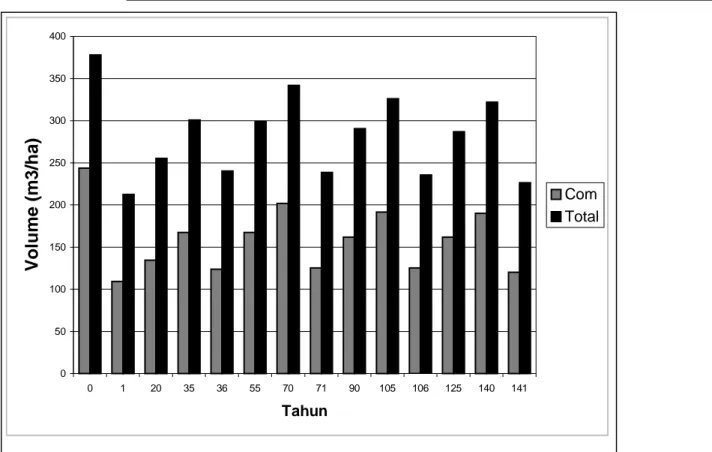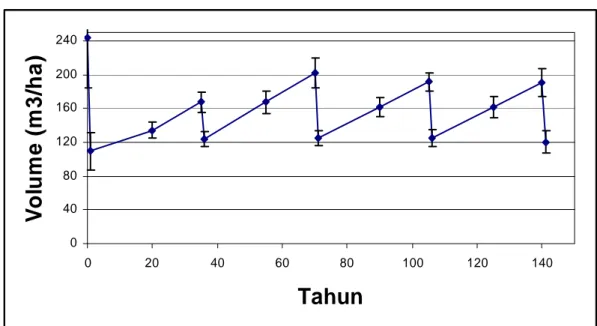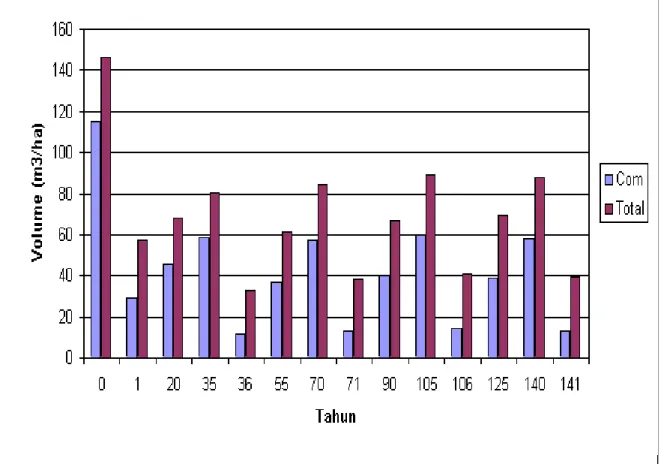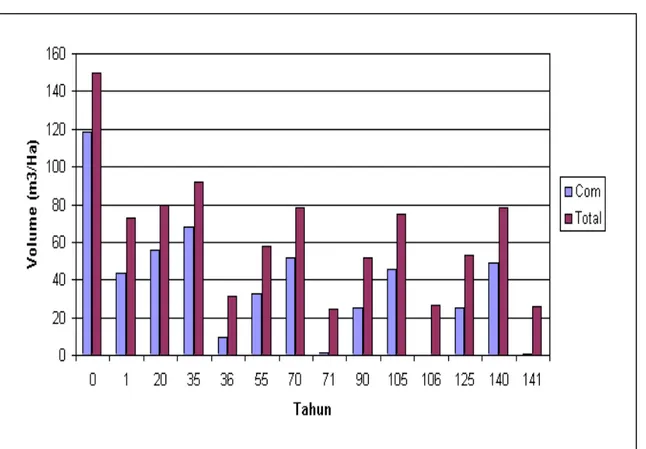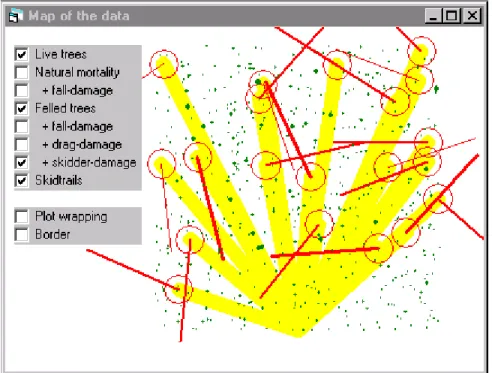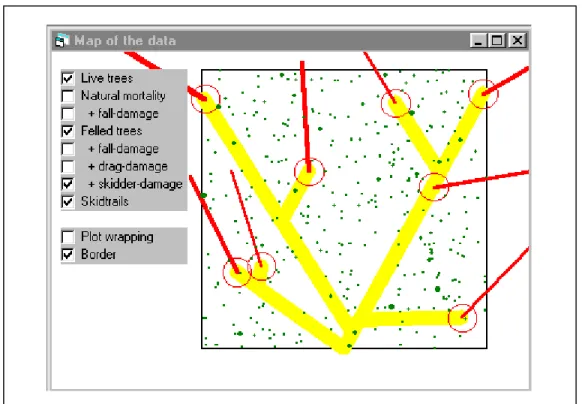This document is an output from a project funded through the Forestry Research Programme of the UK Department For International development (DFID) for the benefit of developing countries. The views expressed are not necessarily those of DFID.
Project R6915 Forestry Research Programme. .
III.2 STUDI KASUS
III.2.1. STUDI KASUS 1 : SIMULASI PERTUMBUHAN DAN HASIL
PRODUKSI DENGAN MODEL SYMFOR oleh FARIDA HERRY SUSANTY DAN EDY SARDJONO
Ringkasan
SYMFOR (Sustainable and Yield Management for Tropical Forests) sebagai alat manajemen merupakan suatu model pertumbuhan tegakan yang dikembangkan untuk hutan tropis dataran rendah di Indonesia yang memprediksi besarnya panenan dan kemampuan pertumbuhan tegakan untuk siklus tebangan selanjutnya dengan beberapa alternatif tindakan pengaturan hasil yang lestari dari konsesi pengusahaan hutan produksi. Juga untuk menilai dan mengevaluasi sistem manajemen (sistem silvikultural) secara ekologi, bukan merupakan model simulasi konsesi hutan secara ekonomi. Kombinasi model pertumbuhan dan hasil (untuk konsesi yang bersangkutan), model ekonomi dan kerangka kerja berwawasan lingkungan (environmental framework) digunakan untuk perencanaan manajemen konsesi hutan secara umum. Tujuan tulisan ini adalah memberikan analisa simulasi dinamika pertumbuhan hutan (struktur dan komposisi) di hutan hujan tropis dataran rendah dengan beberapa kondisi areal (sistem silvikultur) dengan menggunakan SYMFOR dan memberikan simulasi hasil panenan dan tegakan tinggal untuk tindakan Silvikultur TPTI (Tebang Pilih Tanam Indonesia), Sistem RIL (Reduced Impact Logging) dan Sistem Pengaturan Hasil (Yield Regulation) dengan SYMFOR.
Asumsi yang digunakan adalah tidak terjadi degradasi areal konsesi pengusahaan hutan yang antara lain disebabkan oleh kebakaran hutan dan perladangan, tidak terjadi pemungutan hasil hutan (penebangan) yang dilakukan diluar pemegang konsesi Hak Pengusahaan Hutan (HPH) dan penetapan jenis komersial dan non komersial berlaku untuk masa sekarang dalam areal hutan dengan batas (boundries) yang jelas.
III.2 CASE STUDY
III.2.1. CASE STUDY 1 : SIMULATING GROWTH AND YIELD PRODUCTION USING THE SYMFOR MODEL by FARIDA HERRY SUSANTY AND EDDY SARDJONO
Summary
As a forest management tool, SYMFOR
(Silviculture and Yield Management for Tropical Forests) is an individual tree growth model which has been developed for lowland dipterocarp forest in Indonesia, and can be used to formulate harvesting volume and growth capability for the subsequent cutting cycle using several alternative systems for sustainable timber yield regulation from production forest concession. This model can be used to simulate several alternative
silvicultural practices and evaluate the management system (silvicultural system) from ecological point of view, but not as an economic forest simulation model. Combination the growth and yield model (for the concerned concession), the economic model and environmental
framework can be used to produce general forest management activity.
The objective of this report is to present the simulation analysis of the forest growth dynamic (structure and composition) within lowland tropical rain forest with several area conditions (silviculture system) using SYMFOR model; and to present performing simulation to the harvesting result and residual stand for the TPTI (Tebang Pilih Tanam Indonesia – Indonesia Selective Cutting and Felling) system, RIL (Reduce Impact Logging) system and Yield Regulation System using SYMFOR.
Assumptions used in this simulation is that there is no forest degradation occurs both caused by forest fire or shifting cultivation, no illegal logging, and the commercial and non-commercial species assessment is valid for current period
Simulasi SYMFOR menggunakan data yang diperoleh dari Plot STREK yang berumur 10 tahun dengan lima kali pengukuran meliputi jenis, ukuran diameter, bentuk dan posisi tajuk, serta keadaan pohon. Data input simulasi SYMFOR telah divalidasi dan dikoreksi secara estimasi atau pengukuran ulang sehingga bias estimasi dalam simulasi dapat ditekan. SYMFOR sebagai alat simulasi sangat tergantung pada kualitas data input yang digunakan. Input data harus merupakan gambaran representatif untuk kondisi areal tertentu dalam bentuk stratifikasi areal pengusahaan hutan. Dalam studi kasus ini menyatakan bahwa volume produksi (penebangan) pada hutan primer selalu lebih tinggi dibandingkan dengan hutan bekas tebangan. Sedangkan pengusahaan hutan sekarang lebih banyak di areal tebangan sehingga diperlukan data dasar yang aktual dalam pengelolaan hutan. Sistem RIL 70 m3/ha (± 45 m3/ha) dengan pengaturan hasil (yield regulation) memberikan bentuk kelestarian hasil yang lebih baik dibandingkan Sistem TPTI (± 40 m3/ha) dan RIL 8 btg/ha (± 42 m3/ha) terutama untuk areal dengan potensi tinggi. Nilai potensi ini sangat dipengaruhi kondisi awal tegakan dimana potensi tegakan awal sistem TPTI lebih tinggi (± 240 m3/ha) dibandingkan sistem RIL 8 btg/ha dan RIL 70 m3/ha (± 110 m3/ha). Untuk peningkatan volume produksi (siklus tebang kedua) diperlukan pengaturan siklus yang lebih lama (dimungkinkan untuk siklus tebang lebih 35 tahun) untuk mendukung regenerasi pertumbuhan yang cukup (recovery). Untuk estimasi bentuk pertumbuhan dan hasil di masa depan dari alternatif pola manajemen hutan dan pengaturan hasil perlu dilakukan simulasi dengan menggunakan SYMFOR.
Pendahuluan
Latar BelakangSYMFOR (Sustainable and Yield Management for Tropical Forests) merupakan suatu model
pertumbuhan tegakan yang dikembangkan untuk hutan tropis dataran rendah di Indonesia yang memberikan beberapa alternatif pengaturan hasil yang lestari dari konsesi pengusahaan hutan produksi.
within the forest area with clear boundary. SYMFOR simulation uses data obtained from STREK plots which has 10 years of age with five time measurements including tree species, stem diameter, crown position and form, and trees condition. Input data used in the SYMFOR simulation have been validated and corrected through estimation and re-measurement so that simulation bias can be minimised. As a simulation tool, SYMFOR is strongly depend on the input data quality used. The input data should represent the certain area condition in form of forest concession area stratification.
In this study, it was proved that the production volume (harvesting) in the primary forest is always higher than production from logged over forest area. Since most of the current forest concessions are located within logged over forest area, actual database of forest management is required. The RIL 70 m3/ha system (± 45 m3/ha) with yield regulation, gives better sustainable yield form when compare with the TPTI system (± 40 m3/ha) and RIL 8 trees/ha system (± 42 m3/ha) especially for the forest areal with high potential. This value potential is affected by initial condition of the standing stock, where the initial stock condition for the TPTI system is higher (± 240 m3/ha) compare with the RIL 8 trees/ha and RIL 70 m3/ha systems (± 110 m3/ha). To improve the production in the second cutting cycle it is required to determine the longer cutting cycle regulation (posible for cutting cycle more than 35 years) to support regeneration process so that reach a reasonable level. To estimate growth and yield potential in the future about forest
management pattern and yield regulation alternatives it is necessary to make simulation by using SYMFOR.
Introduction
Background
SYMFOR (Silviculture and Yield Management for Tropical Forests) is an individual tree growth
Model ini menunjukkan pertumbuhan tegakan hutan yang berdasarkan pada jenis (species), ukuran (kelas diameter) dan kondisi tegakan secara individual. Manajemen hutan dengan sistem silvikultur yang berbeda akan memberikan dampak yang berbeda, baik dari segi kondisi sekarang (kerusakan tegakan) maupun kondisi di masa datang (berubahnya fungsi hutan). SYMFOR sebagai suatu alat manajemen hutan dapat digunakan dalam memberikan
perbandingan beberapa alternatif tindakan silvikultur yang dilaksanakan untuk memprediksi besarnya panenan dan kemampuan pertumbuhan tegakan untuk siklus tebangan selanjutnya.
Pertumbuhan tegakan hutan ditunjukkan dengan perubahan dalam jumlah batang, volume atau bidang dasar selama jangka waktu tertentu. Komponen model pertumbuhan utama yang meliputi riap diameter (diameter increment), pertumbuhan permudaan (in-growth/recruitment), kematian (mortality) dan kerusakan akibat penebangan (logging damage) sebagai dasar untuk simulasi pertumbuhan, merupakan salah satu komponen dalam simulasi kelestarian manajemen. SYMFOR
merupakan model pertumbuhan dan hasil yang dipergunakan untuk menilai dan mengevaluasi sistem manajemen (sistem silvikultural) secara ekologi, bukan merupakan model simulasi konsesi hutan secara ekonomi. Kombinasi model pertumbuhan dan hasil (untuk konsesi yang bersangkutan), model ekonomi dan kerangka kerja berwawasan lingkungan (environmental framework) digunakan untuk perencanaan manajemen konsesi hutan secara umum. Karakteristik hutan tropis (antara lain : struktur dan komposisi yang kaya dan umur pohon tidak
diketahui) memberikan kesulitan dalam memberikan model hasil panenan secara individual jenis.
Sehingga diperlukan adanya pengelompokan spesies berdasarkan tipe pertumbuhan yang hampir sama dan hubungan volume lebih erat berdasarkan pada bidang dasar daripada dengan umur.
model which has been developed for lowland dipterocarp forest in Indonesia, and can be used to formulate alternative systems for sustainable timber yield regulation from production forest concessions. This model simulates the growth of forest standing stock using PSP data on the species, size (diameter class), and position of each individual tree in the stand. Different forest management and silvicultural systems can be simulated and the impacts upon current condition (tree damage), and future forest condition assessed. As a forest management tool SYMFOR can be used to simulate several alternative silvicultural practices to predict commercial timber volume in an initial harvest, and then to look at the subsequent regeneration of the stand in order to asses when a second harvest will be viable.
Forest growth is depicted by the change in the number of trees, total volume and basal area (all disaggregated by species group) over a certain period of time. The main growth model
components are diameter increment, recruitment and mortality – logging damage is an important element of mortality, used when any extraction of timber is performed. SYMFOR is a Growth and Yield Model, which can be used to evaluate alternative management systems (sivicultural system) from the ecological pint of view. It is not a model of forest concession economics, but its principal output – timber yield – forms an essential input for such models. A combination of growth and yield simulation models with
economic models and an environmental framework can be used for general forest management planning.
Tropical forest characteristics, such as great species diversity, complex structure and mixed (unknown) tree age cause difficulties in designing models which can accurately represent the impacts of forest harvesting. Therefore it is necessary to group the species according to growth characteristics and dbh : volume
relationships which are determined by measuring basal area rather than by attempting to estimate age.
Untuk memberikan hasil simulasi yang dapat mendekati kebenaran (bias kecil), diperlukan unit sampling yang mewakili (representatif) untuk semua stratifikasi areal yang ada pada suatu konsesi
pengusahaan hutan. BFMP (Berau Forest Management Project) menggunakan data sampling dari plot STREK (Silviculture Techniques for the Regenaration of Logged-over Forest in East Kalimantan) sebagai plot permanen 10 tahun yang lalu. Setiap data diesensil untuk model pertumbuhan dan hasil dan sebagai input untuk dijalankan. Data tersebut juga harus divalidasi (dikoreksi) untuk meminimalkan bias yang terjadi sebelum digunakan untuk tujuan modeling.
A. Tujuan
Tujuan dari tulisan ini adalah sebagai berikut : 1. Memberikan analisa simulasi dinamika
pertumbuhan hutan (struktur dan komposisi) di hutan hujan tropis dataran rendah dengan beberapa kondisi areal (Sistem Silvikultur) dengan
menggunakan SYMFOR
2. Memberikan simulasi hasil panenan dan tegakan tinggal untuk tindakan
Silvikultur TPTI (Tebang Pilih Tanam Indonesia),
Sistem RIL (Reduced Impact Logging) dan Sistem pengaturan hasil (Yield Regulation)
dengan SYMFOR
B. Asumsi-asumsi
Simulasi dalam model SYMFOR mengasumsikan beberapa hal, yaitu :
1. Tidak terjadi degradasi areal konsesi pengusahaan hutan yang antara lain disebabkan oleh kebakaran hutan dan perladangan
2. Tidak terjadi pemungutan hasil hutan
(penebangan) yang dilakukan diluar pemegang konsesi Hak Pengusahaan Hutan (HPH) 3. Penetapan jenis komersial dan non komersial
berlaku untuk masa sekarang
In order to ensure the accuracy of simulation results for planning on a concession scale it is necessary to use data from representative sample plots, covering all strata which exist in the forest concession. BFMP (Berau Forest Management Project) have collected sample data from the STREK (Silvicultural Techniques for the Regeneration of Logged-over Forest in East Kalimantan) permanent sample plots (PSPs) over the last 10 years. Such data is essential for building forest growth and yield models and as input for running them. This data must be checked for accuracy and consistency before it can be used for modeling purposes.
A. Objective
The objectives of this study were as follows: 1. To use the SYMFOR model to represent
alternative harvesting and silvicultural systems and to observe forest growth dynamics
following logging within areas of lowland tropical rain forest of different conditions. 2. To analyse commercial timber yield and the
condition and regrowth of the residual stand under the following conditions:
TPTI (Tebang Pilih Tanam Indonesia) silviculture practice,
RIL (Reduced Impact Logging) system
A system of Yield Regulation
B. Assumptions
The results obtained from the SYMFOR simulation process are valid under the following
assumptions:
1.There is no degradation of the concession area caused, for instance, by forest fire or shifting cultivation.
2.There is no illegal logging.
3.The species currently considered as
commercial/non-commercial remain the same in subsequent harvests.
Metodologi Model SYMFOR Aplikasi Model SYMFOR
Model SYMFOR dalam manajemen hutan secara lestari (Sustainable Forest Management/SFM) dapat dipergunakan memprediksi pertumbuhan pohon, hasil tebangan dan tegakan tinggal (standing stock) pada setiap periode (tebangan tahunan) sehingga akan diketahui jangka waktu tegakan yang diperlukan tegakan mencapai tingkat klimaks.
Data Dasar (Database) untuk Model SYMFOR SYMFOR menggunakan data hasil PUP dari Plot STREK (Silviculture Techniques for Regeneration of Logged Over Forest) PT. Inhutani I Berau di
Kalimantan Timur. Lokasi PUP terletak pada RKL IV berjumlah 12 plot (48 ha)
Data yang dipergunakan dalam simulasi SYMFOR merupakan data yang telah divalidasi (correction datas) untuk memperoleh kualitas data sesuai dengan standar eror yang digunakan. Dengan menentukan tingkat eror data dan sumbernya, sehingga dapat dilakukan koreksi data sebelum simulasi.
Penggunaan Model SYMFOR
Simulasi model SYMFOR dilakukan terhadap silvikultur sistem Tebang Pilih Tanam Indonesia (TPTI) dan Pembalakan Dampak Rendah (Reduced Impact Logging/RIL) dengan pengaturan hasil (Yield Regulation).
a). Ciri-ciri umum sistem TPTI
Rotasi tebangan 35 tahun, faktor eksploitasi 0,7 dan faktor pengaman 0,8
Penebangan limit diameter >50 cm untuk HP dan >60 cm HPT.
Kenyataan dilapangan pelaksanaan tebangan tidak direncanakan pembukaan terlebih dahulu jalan sarad dan arah tebangan (TPTI konvensional)
Methodology of SYMFOR Model SYMFOR Model Application
SYMFOR can be used to predict individual tree growth, the total yield from a stand of forest and the condition of the residual stand at specified intervals, so that an optimal cutting cycle can be evaluated.
Data requirements for SYMFOR Model
SYMFOR uses Permanent Sample Plot (PSP) data on the species, DBH and position of each tree in the plot. The PSP data used to produce this report was obtained from the STREK (Silvicultural Techniques for Regeneration of Logged over forest) plots of PT. Inhutani I, Berau East Kalimantan. The PSP areas are located in RKL IV with 12 plots in total (48 Ha)
The data used in the SYMFOR simulation must be validated before use. This is to ensure that the data is of a high quality and suitable to work with and to base predictions upon. By checking the data for errors and their sources, data correction can be done before the simulation process is performed.
SYMFOR Model Application
The SYMFOR model simulation was carried out implementing the TPTI (Tebang Pilih Tanam Indonesia - Indonesian Selective Cutting and Planting) silvicuture system and a Reduced Impact Logging (RIL) system with yield regulation.
a) General characteristics of TPTI
Cutting cycle is 35 years, exploitation factor 0.7 and safety factor 0.8;
Tree diameter limit to be cut is >=50 cm for production forest and >=60 cm for limited production forest.
The normal practice in the field is that trees are felled with no pre-planning of felling direction or skid trails (Conventional TPTI).
b). Pembalakan Dampak Rendah (RIL)
• Kegiatan pengelolaan hutan telah dibuat pada tahap awal
• pembuatan jalan sarad dan arah tebang sebelum penebangan
Dalam simulasi ini menggunakan jumlah pohon yang ditebang 8 batang per ha (RIL 8) dan dan volume 70 m3 per ha (RIL 70).
Analisis Model SYMFOR
SYMFOR menggunakan metode statistik dengan mengadakan ulangan pada setiap simulasi. Dua hal yang diperlukan yaitu; Pertama karena Nilai rata-rata dari hasil ulangan simulasi dibuat model dengan metode statistik untuk memperoleh kecenderungan pola pertumbuhan dan hasil produksi sesuai dengan prediksi siklus tebangan dan riap tahunan tegakan. Kedua karena dalam rangka membuat perkiraan akurat tingkat panen dan status hutan dimasa datang, model tersebut harus dioperasikan dengan menggunakan data yang dikoleksi dari beberapa PSP yang berbeda. Hasil harus di rata-rata terhadap jumlah pengulangan untuk masing-masing petak dan antar petak.
Pengukuran kesalahan standard (standard error) dari nilai rata-rata juga harus diperhitungkan sehingga memberikan gambaran cakupan nilai-nilai yang diperoleh untuk suatu pengukuran.
Hasil
Hasil simulasi dengan input variabel data dari Plot STREK RKL 4 diperlihatkan dibawah ini: Sistem TPTI, RIL 8 batang/ha dan RIL 70 m3/ha untuk siklus tebang 35 tahun selama 140 tahun ditunjukan pada Tabel 1, Tabel 2 dan Tabel 3.
b) Reduced Impact Logging (RIL)
• Forest management and harvesting activities are planned before felling begins.
• Skid trails are pre-planned and stems are felled in relation to these skid trails (in order to make the skidding operation faster, easier and less damaging to the residual stand) In this simulation the maximum number trees felled is 8 trees per Ha (RIL8) and the maximum volume extracted is 70 m3 per Ha (RIL 70) Analysis of the results from SYMFOR
The data output by SYMFOR at the end of each simulation must be subjected to some statistical analysis. This is necessary for two reasons. Firstly because there are a number of random processes occurring in the model – the same run must therefore be repeated several times as no two runs produce the same result. Secondly because in order to make accurate predictions of the harvest level and status of the forest in the future the model must be run using data collected form several different PSPs.
Results must be averaged over the total number of repetitions for each plot and between plots. A measure of the standard error (SE) of the average value should also be calculated in order to give an idea of the range of values obtained for any measurement.
Results
The results from simulations using input data from various STREK PSPs in RKL4 are shown below. The silvicultural systems used were: Conventional TPTI (Table 1), RIL 8 stems/Ha (Table 2) and RIL 70 m3/Ha (Table 3), all the simulations were run for 140 years on a 35 year cutting cycle.
Tabel 1
Estimasi produksi jenis komersial dengan sistem TPTI konvensional siklus tebang 35 tahun
dengan limit diameter 50 cm.
Table 1 Simulated production of commercial timber using conventional TPTI system under a 35 year cutting cycle and a diameter limit of 50 cm.
Panen
Harvest
Number
Tahun
Year
Volume (m3/ha)
Volume harvested
Diameter (cm)
Average DBH of harvested treesN. Pohon (btg/ha)
Tree felled
1
0
97.7
±
33.1
74.8
±
6.1
13.1
±
3.9
2
35
27.4
±
6.8
61.4
±
1.5
6.2
±
1.6
3
70
45.7
±
8.6
62.7
±
1.2
9.7
±
1.9
4
105
39.2
±
3.9
62.1
±
0.7
8.6
±
0.9
5
140
40.2
±
5.9
61.8
±
0.8
8.9
±
1.1
Gambar 1. Potensi Produksi Tegakan (m3/ha) untuk jenis komersial dan total tegakan dengan sistem TPTI
Figure 1. Potential of Standing Stock Production (m3/ha) for commercial species and total
standing stock using TPTI system
0 50 100 150 200 250 300 350 400 0 1 20 35 36 55 70 71 90 105 106 125 140 141 Tahun
Vo
lu
me (m3/
h
a
)
Com TotalGambar 2. Proporsi jenis komersial yang ditebang dengan sistem TPTI
Figure 2.
Breakdown of commercial species harvested using TPTI system
0% 10% 20% 30% 40% 50% 60% 70% 80% 90% 100% 1991 2026 2061 2096 2131 S low Dipterocarps Fast Dipterocarps M eranti
Potensi tegakan tinggal jenis komersial dengan limit diameter 10 cm dengan sistem TPTI dalam siklus tebangan untuk simulasi 140 tahun sebagai berikut :
The residual stand stocking of commercial species (with diameter limit of over 10 cm) is shown below. The simulation ran for 140 years using the TPTI system.
Gambar 3. Kondisi Tegakan Tinggal untuk jenis komersial dengan Sistem TPTI.
Figure 3. Residual stand stocking of commercial trees using TPTI system
0 40 80 120 160 200 240 0 20 40 60 80 100 120 140
Tahun
Vo
lu
m
e
(
m
3
/h
a
)
Tabel 2. Estimasi produksi jenis komersial dengan sistem RIL 8 batang/ha siklus tebang 35 tahun dengan limit
diameter 50 cm.
Table 2
Simulated production of commercial species using RIL 8 stems/Ha system with a 35 year cutting cycle
and diameter limit of 50 cm.
Tebangan
Harvest
Number
Tahun
Year
Volume (m3/ha)
Volume Harvested
Diameter (cm)
Average DBH of
harvested trees
N. Pohon
Average Number of
Tree felled (Trees/Ha)
1
0
79.9±20.0
89.0±10.4
7.6±0.3
2
35
44.1±9.2
70.1±5.2
7.3±0.5
3
70
41.0±4.3
68.2±2.3
7.3±0.3
4
105
42.4±3.9
68.5±2.7
7.5±0.1
5
140
41.8±3.1
68.3±2.0
7.5±0.3
All data are reported ± one standard error
.
Gambar 4. Potensi Produksi Tegakan (m3/ha) untuk jenis komersial dan total tegakan dengan Sistem RIL 8
btg/ha
Figure 4. Simulated Production potential (m3/ha) showing commercial species only and total standing stock,
harvested using the RIL 8 trees/ha system.
Gambar 5. Kondisi Tegakan Tinggal jenis Komersial dengan Sistem RIL 8 btg/ha
Figure 5. Volume of Commercial timber in the residual stand under the RIL 8 trees/Ha system
(first harvest in year 1990, 35 year cycle)
0 25 50 75 100 125 150 1980 2000 2020 2040 2060 2080 2100 2120 2140 Year C o mm er c ia lVo lu me ( m3 /h a )
Tabel 3.
Estimasi produksi jenis komersial dengan Sistem RIL 70 m3/ha siklus tebang 35 tahun
dengan limit diameter 50 cm.
Table 3.
Simulated production of commercial species using the RIL 70 m3/Ha system, with a 35 year cutting
cycle and diameter limit of 50 cm.
Panen
Harvest
Number
Tahun
Year
Volume (m3/ha)
Volume Harvested
Diameter (cm)
Average DBH of
harvested trees
N. Pohon
Average Number of
Tree felled (Trees/Ha)
1
0
68.9±10.9
95.9±17.5
6.2±2.1
2
35
54.7±13.0
70±6.4
9.0±1.3
3
70
47.1±5.2
62.9±1.8
10.1±1.0
4
105
42.0±4.2
61.0±1.1
9.8±0.8
5
140
45.8±5.1
61.5±1.1
10.4±1.0
Gambar 6.
Potensi tegakan tinggal (m3/ha) untuk jenis komersial dan total tegakan dengan sistem RIL 70
m3/ha
Figure 6. Simulated Production Potential (m3/Ha) for commercial species only and total standing stock,
harvested using RIL 70 m3/ha system
Gambar 7. Kondisi Tegakan Tinggal Jenis Komersial dengan sistem RIL 70 m3/ha
Figure 7. Volume of Commercial timber in the residual stand under the RIL 70 m3/ha system (first harvest in
year 0, 35 year cycle)
0 25 50 75 100 125 150 0 20 40 60 80 100 120 140 160 Tahun Vo lu m e k o m er si a l (m3/ h a )
Pembahasan
Dalam estimasi produksi (Yield) dengan sistem TPTI menunjukkan bahwa dengan siklus tebangan kedua terjadi penurunan potensi produksi yang cukup ekstrim dari 97,7 ± 33,1 m3/ha menjadi 27.4 m3/ha yaitu dengan menurunnya jumlah pohon yang siap tebang pada siklus tebang kedua tersebut (± 13 btg/ha menjadi ± 6 Btg/ha). Penurunan potensi produksi (volume) ini juga terlihat pada sistem RIL 8 btg/ha dan RIL 70 m3/ha walaupun tidak terlalu ekstrim. Potensi produksi pada sistem TPTI mempunyai variasi yang cukup besar untuk setiap siklus tebang. Variasi ini disebabkan karena penebangan pada siklus tebang pertama terlalu besar sedangkan pertumbuhan tegakan setelah 35 tahun (siklus tebang kedua) belum dapat menyediakan potensi yang sama. Potensi tebangan setelah siklus tebang kedua membentuk pendekatan kelestarian dengan rata-rata hasil 40 m3/ha walaupun masih terlihat adanya variasi. Sistem RIL 8 btg/ha pada setelah siklus tebang kedua (35 tahun) menunjukkan bentuk kelestarian hasil yang lebih baik dibandingkan dengan kedua sistem yang lain, dengan potensi produksi sebesar 42 m3/ha. Sedangkan dengan dasar sistem pengaturan hasil RIL 70 m3/ha, kondisi hutan mempunyai potensi produksi yang lebih tinggi dengan rata-rata 45 m3/ha. Kedua sistem ini mempunyai variasi jumlah pohon siap tebang yang lebih kecil dibandingkan dengan sistem TPTI. Dari nilai tersebut menunjukan bahwa RIL dengan pengaturan hasil berdasarkan volume maksimal 70 m3/ha mempunyai nilai kelestarian hasil yang lebih tinggi.
Secara umum hasil simulasi ini menunjukkan bahwa penebangan pada awal konsesi di areal hutan primer akan jauh lebih besar dibandingkan pada areal bekas tebangan. Potensi produksi tegakan akan menurun secara nyata sehingga diperlukan suatu sistem silvikultur untuk dapat meningkatkan produksi secara lestari.
Saat ini di Indonesia tinggal tersisa sedikit area hutan primer untuk ditebang – mayoritas dikelola untuk hutan produksi. Hal ini menunjukkan bahwa sistem
pengelolaan hutan diciptakan untuk hutan primer, tidak dapat digunakan untuk hutan bekas tebang. Studi ini menunjukkan bahwa pengelolaan hutan bekas tebang memerlukan suatu format pengaturan hasil yang
Discussion
Forest growth and yield simulation under the TPTI system shows that an extreme decline in production occurs in the second harvest : from 97.7 ± 33.1 m3/Ha to 27.4 m3/Ha. This is in line with the decreasing number of trees harvested (13.1 ± 3.9 trees/Ha to 6.2 ± 1.6 trees/Ha). This decreasing production (commercial volume) is also observed in the RIL 8 trees/Ha and RIL 70 m3/Ha systems, although it is not as extreme. Commercial timber production in the TPTI system shows a large variation between cutting cycles. This variation is primarily caused by the harvesting of too great a volume in the first cutting cycle, while the residual stock growth rate over the 35 years up to the second harvest is insufficient to replace the harvested volume. A sustainable yield for the second and subsequent harvests averages 40 m3/Ha, although slight variation still occurs.
After the second harvest (at 35 years), the RIL 8 trees/Ha system shows better yield sustainability than the TPTI system, with a production potential of 42 m3/ha. Meanwhile, using the RIL 70 m3/ha system, the forest has a higher production potential with average volume of 45 m3/ha every 35 years. Both of these systems show a small variation in the actual number of stems cut from harvest to harvest. The results of the above analysis indicate that RIL system with yield regulation of maximum 70 m3/ha has the greatest potential for sustainable timber production. In general, this simulation result indicates that the timber yield obtainable from virgin forest is much higher than the yield from logged over areas. Standing stock potential declines significantly after the first harvest, so that a specific
silvicultural or yield regulation system is required limit timber production, and hold it at a
sustainable level.
At present in Indonesia there are few areas of virgin forest remaining to be logged - the majority of managed production forests have already been logged over. It is evident that the management system that was created for virgin forest cannot be used for logged over forest. This study has shown that the management of logged over forest requires a form of yield regulation which is
disesuaikan dengan potensi tegakan hutan. Inventarisasi data diperlukan untuk memberikan informasi pada potensi tegakan dari hutan bekas tebang.
Perbedaan sistem TPTI dan RIL dengan pengaturan hasil di lapangan dapat ditunjukkan dengan perbedaan :
1. Pola jalan sarad yang terbentuk 2. Tingkat keterbukaan areal
3. Tingkat kerusakan tegakan (permudaan) Pola pembukaan areal dengan sistem TPTI dapat terlihat pada gambar berikut :
matched to the standing stock (potential) of the forest. Inventory data is necessary to provide this information on the standing stock of logged over forest.
In the field the differences between TPTI and RIL with yield regulation fall into the following areas: 1. Skid trail planning
2. The level of canopy opening caused by logging 3. The amount of damage to the residual stand The canopy opening as a result of skid trail creation under the TPTI system can be seen in the following figure:
Gambar 8. Pola penebangan dan jalan sarad pada sistem TPTI
Figure 8. Felled trees and skid trail pattern in the TPTI system
Sedangkan untuk pola pembukaan areal untuk sistem RIL dan pengaturan hasil sebagai berikut :
The canopy opening and skid trail pattern under the RIL system with yield regulation is as follows:
Gambar 2. Pola penebangan dan jalan sarad dengan sistem RIL dan pengaturan hasil.
Figure 9. Felled trees and skid trail pattern using the RIL system with Yield regulation.
Dari gambar di atas ditunjukkan perbandingan tingkat kerusakan areal dan tegakan dengan sistem yang berbeda. Dengan sistem RIL pola jalan sarad, arah rebah pohon, telah dipertimbangkan dalam tahap perencanaan, sehingga dimungkinkan untuk meminimalkan terjadinya kerusakan akibat penebangan.
Hasil simulasi menunjukkan bahwa dengan sistem pengelolaan berwawasan lingkungan dengan pengaturan hasil berdasarkan volume maksimal yang ditebang (RIL 70 m3/ha) memberikan bentuk kelestarian hasil yang lebih baik. Dalam sistem ini volume potensi produksi yang terbentuk dalam pola kelestarian hutan lebih besar yaitu ± 45 m3/ha. Sedangkan dengan sistem RIL 8 btg/ha volume produksi ± 42 m3/ha dan sistem TPTI sebesar ± 40 m3/ha.
The above figures show a comparison of the trees felled and areas damaged under different systems. With the RIL system, skid trail pattern and felling direction have been considered in the planning phase, so that the environmental damaged caused by logging activities can be minimised.
The simulation results indicate that forest planning and management using RIL and a yeild regulation of 70 m3/Ha gives a more sustainable yield and causes less damage to the residual stand. Under this system, sustainable commercial timber production is approximately 45 m3/ha. Meanwhile, timber production obtained from the RIL 8 trees/ha system is approximately 42 m3/ha and from the TPTI system approximately 40 m3/ha.
Volume kayu komersial dihitung dengan SYMFOR selama simulasi yang merupakan volume tegakan di hutan.
Setelah simulasi, faktor utilisasi (kombinasi dari faktor eksploitasi dan faktor keamanan) harus diaplikasikan untuk memperhitungkan kayu yang terbuang di hutan selama operasi penebangan dan pengangkutan pohon. Perhitungan volume komersial bersih diberikan kepada perusahaan kayu. Departemen Kehutanan dan
Perkebunan menggunakan faktor utilisasi 0,7 (30% volume komersial tegakan hilang selama ekstraksi), sedangkan BFMP menggunakan faktor 0,52 (48% terbuang). Gambaran ini diperoleh dari percobaan lapang pemanenan STREK. Hasil di atas menunjukkan bahwa aplikasi RIL dan pengaturan hasil 70 m3/ha pada siklus tebang 35 tahun, volume komersial bersih akan berkisar antara 23 m3/ha – 31 m3/ha. Dalam konsep ini menunjukkan bahwa melalui minimalisasi volume yang terbuang di areal penebangan akan meningkatkan potensi produksi bagi pengusahaan hutan.
Kesimpulan
Beberapa hal yang dapat disimpulkan dalam laporan ini adalah :
1. Sistem RIL 70 m3/ha dengan pengaturan hasil (yield regulation) memberikan bentuk kelestarian hasil yang lebih baik dibandingkan sistem TPTI dan RIL 8 btg/ha berdasarkan besarnya potensi produksi terutama untuk areal dengan potensi tinggi.
2. Volume produksi (penebangan) pada hutan primer selalu lebih tinggi dibandingkan dengan hutan bekas tebangan. Sejak sebagian besar hutan dibawah pengelolaan, di Indonesia hutan bekas tebang (sekali) hasil kayunya pada siklus tebang kedua secara signifikan lebih rendah dibandingkan dengan tebang pertama. Untuk mengelola hutan bekas tebang diperlukan sebuah sistem yang fleksibel – berupa peraturan penebangan yang diijinkan per ha, sesuai dengan kondisi aktual / potensi hutan.
The commercial timber volume calculated by SYMFOR during simulations is the standing volume in the forest.
After the simualtion, the ‘utilisation factor’ (a combination of the exploitation and safety factors) must be applied to allow for wastage which occurs in the forest during felling and skidding
operations. This calculates the net commercial volume delivered to the mill gate. The Ministry of Forestry and Estate Crops uses a utilisation factor of 0.7 (ie 30% of the standing commercial volume is lost during extraction), wheras BFMP uses a factor of 0.52 (ie 48% wastage). This figure comes directly from the STREK harvesting trials. The above results show that with the application of RIL and yield regulation of 70 m3/ha for the 35 years cutting cycle, the net commercial volume will be between 23 m3/ha – 31 m3/ha. This also highlights the fact that by minimising timber wastage during felling and extraction, timber production (and therefore profits) will be increased.
Conclusions
Several conclusions can be made from this report, these are:
1.For primary forest the RIL 70m3/ha yield regualtion system produces the best long-term sustainable yield. The TPTI and RIL 8 stems/ha systems give a more variable yield.
2.Timber production potential from primary forest is always higher than the production potential from logged over areas. Since most forests under management in Indonesia have now been logged over once, the timber harvest from the second cycle will be significantly lower than from the first. For management of logged over forests a flexible system is needed – it should regulate the allowable cut per ha according to the actual condition/potential of the forest.
3. Untuk peningkatan volume produksi (siklus tebang kedua) diperlukan pengaturan siklus yang lebih lama (dimungkinkan untuk siklus tebang lebih 35 tahun) untuk mendukung regenerasi.
4. Untuk estimasi bentuk pertumbuhan dan hasil di masa datang dan untuk mengevaluasi dampak dari alternatif silvikultur dan pengelolaan hutan, diperlukan penggunaan model simulasi pertumbuhan seperti SYMFOR. Hal ini terkait dengan proses dasar dari rekruitmen, pertumbuhan dan kematian pohon dan penangkapan gangguan areal yang disebabkan oleh pemanenan.
5. Simulasi SYMFOR memerlukan sistem validasi dan koreksi data untuk data input sehingga diperoleh kualitas data yang baik. Tanpa input data yang akurat, perkiraan pertumbuhan dan hasil yang akan datang tidak dapat diandalkan.
6. Faktor utilisasi (0,52) menunjukkan perbedaan antara volume komersial tegakan dengan volume yang diberikan kepada ‘mill gate’. Hal ini berarti bahwa 48% dari stok komersial tegakan terbuang – salah satu cara sederhana untuk memperbaiki produktivitas dan profitabilitas (mendukung kelestarian hutan) dari sebuah konsesi adalah mengurangi tebang sisa (waste).
3.In order to increase the volume of timber harvested in the second and subsequent cycles a longer cutting cycle is needed (ie greater than 35 years). This will allow the forest a greater amount of time for
regeneration following the previous harvest. 4.In order to estimate the growth and yield of an area of forest into the future and to evaluate the impact of silvicultural and forest management alternatives, it is necessary to use growth simulation models such as SYMFOR. These incorporate the fundamental processes of recruitment, growth and
mortality and capture the spatial disturbances caused by harvesting.
5.SYMFOR requires high quality input data from Permanent Sample Plots – this must be checked and validated before use in the model. Without accurate input data
predictions of future growth and yield will not be reliable.
6.The Utilisation factor (0.52) represents the difference between the standing commercial volume and the volume delivered to the mill gate. This means that 48 % of the
commercial standing stock is wasted – one of the simplest ways to improve the productivity and profitability (and therefore the
sustaianbility) of a concession is to reduce this wastage.
